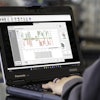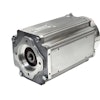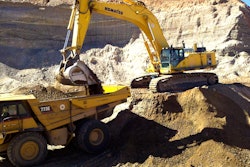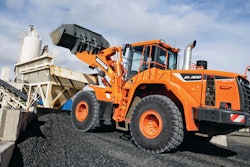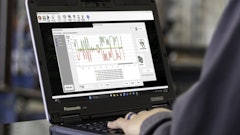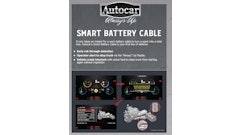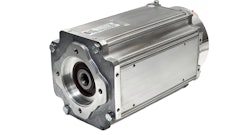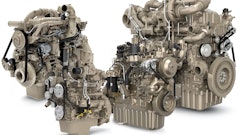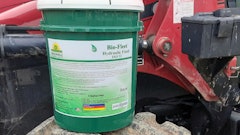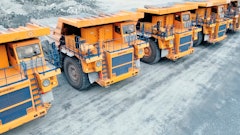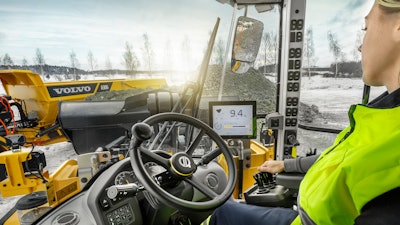
Payload management systems allow you to take control of productivity while eliminating over- and under-loading of trucks. These systems can also reduce loading time and truck traffic. When operators load the right amount of material on the truck every time, more work gets done. Instant feedback improves operator accuracy and speed. This optimizes time, fuel and component life — virtually eliminating maintenance and liability issues due to overloading.
Fewer trips are needed to complete the task. That translates to increased revenue considering that most loads run between 5% and 8% under weight of maximum legal gross vehicle weight (GVW). The savings apply to fuel and other expenses related to operating the vehicle.
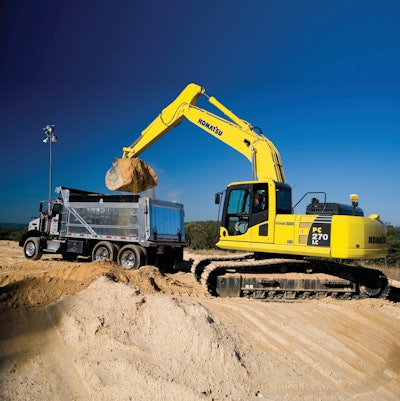 Payload management systems, such as the Trimble LOADRITE system, allow operators to maximize legal payload and reduce overload fines.
Payload management systems, such as the Trimble LOADRITE system, allow operators to maximize legal payload and reduce overload fines.
The key is the ability to obtain actionable data. “Tracking production by using onboard weighing systems gives you the ability to monitor individual operators for both fuel consumption and production,” says Eric Yeomans, product manager - GPPE products, Volvo Construction Equipment. “Tracking the payload can also help you understand material flow on the site. This can help in assessing and improving performance in the hauling processes on site — for example, the fuel cost of transporting material X from point A to B.”
Off-Road Environment Transformed
GPS systems have allowed contractors to track cut and fill locations on the jobsite and better manage projects. And while payload management systems have been available for quite a while, being able to integrate quantities moved with the GPS coordinates creates new opportunities. “The application of this new dimension of measurement is driving a transformational change,” says Kevin Lai, segment manager, onboard weighing, Trimble LOADRITE.
In the past, a contractor may have paid an employee to count truckloads. “This employee was only measuring movement, not how much material got moved,” notes Lai. “But if you measure how many tons the contractor moved, we see this changing the way contracts are done.”
He adds, “Knowing the location is one thing, but to have payload is another dimension of measure. Payload is the actual measurement of work over time or the project progress. You can track how many truckloads in an hour and how much material is moved. The foreman knows how much material must be moved each day, so this information provides insight if changes need to be made.”
You can track material movement on the jobsite in real time. “If you can link the loader to the truck, you know where the materials are going,” says Lai. “You can tell if the job is progressing as planned.”
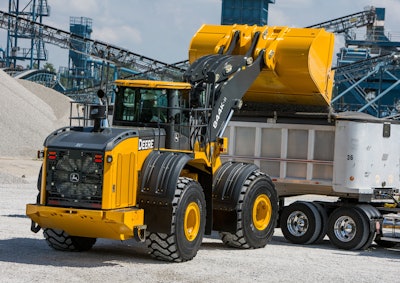 Integration of the Trimble LOADRITE system with OEM telematics systems allows customers to closely track productivity in real time.
Integration of the Trimble LOADRITE system with OEM telematics systems allows customers to closely track productivity in real time.
It is possible to match loads to the optimum designated capacities. “For articulated haulers specifically, proper load weight in the truck ensures maximum productivity and fuel efficiency with minimum overall maintenance costs,” says Yeomans.
“The Volvo onboard weighing system for articulated haulers is also connected to CareTrack, which means that customers can monitor and analyze productivity and efficiency information, as well as machine health data off board,” says Yeomans. “You can track individual bucket loads to help ensure a good pass match between the loading tool and the truck, which helps to properly size the loading tool. Tracking individual truck loads on a large construction jobsite can help determine when a shift of machinery to another cut or fill area is necessary, allowing for a smooth transition of resources on the jobsite.”
Many earthmoving projects include penalties for every day you are late. “If you can make sure you don’t go over one day, the payload management system is going to pay for itself,” says Lai.
Bidding earthmoving projects begins by making several assumptions. “You make an assumption about the density of the material you move,” says Lai. “But that assumption may not be right all of the time. It might be right in one spot and it might not be right in another spot.” Regardless of the density of the material, the payload management system allows every load to be optimized every time.
And since these systems automate a process that has been manually tracked by hand for the last 100 years, reliability of the data is increased. “Automation provides data that you can actually analyze,” says Lai. “You can improve your bids to be much more accurate and with higher confidence. It is a transformational change.”
Stay Within Design Limits
On a construction site with off-road trucks, overloading is often not perceived as a problem. But even in the off-road environment, loading trucks beyond capacity can drive up costs and slow cycle times.
“While DOT restrictions do not apply to off-road trucks, payload management systems provide information that eliminates overloading,” says Yeomans. “Continuous overloading has the potential to reduce the life of components, axles and even tires. Overloading also increases fuel consumption and affects cycle times. “You should never reach a 20% overload.”
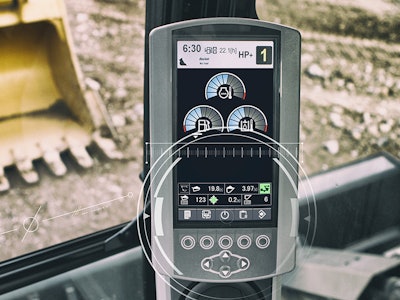
“Our truck systems are not designed to limit how customers use their trucks,” says Mike Mesnard, product application specialist, Caterpillar. “They are simply to provide information to better manage payload and maximize the life and utilization of the truck.”
Overloading an off-road truck doesn’t have the same impact on every jobsite. “The impact of overloading varies by application,” says Mesnard. “For example, an overloaded truck on a smooth haul road might not see the negative impact as severely as a truck in a high rolling resistant, soft underfoot [condition] that causes frame racking and increased stress on the drivetrain and other components.”
Caterpillar’s payload system is a main driver in its 10/10/20 policy. “This 10/10/20 policy states that 90% of all payloads should be less than 110% of rated target payload,” says Schmidtgall. “No more than 10% of all payload should exceed 10% above the rated target payload, and at no time should rated target payload be exceeded by 20%. The ideal haul strategy that maximizes machine component life is to keep the mean of all payloads at or below the machine’s rated target payload.
“The rated capacity of tires should always be considered in any evaluation, as well, as they can be major cost drivers,” he adds.
Optimize for Legal Loads On Roads
One thing to consider when dealing with road-legal trucks is that stationary scales do not improve loading efficiency. Even in quarries where there are platform scales, dump trucks don’t get loaded on the platforms. Therefore, if they are under loaded, they simply leave. If they are overloaded, they pull off to one side and tip material out, then get back in line to be re-weighed.
“On-board weighing affects your production flow and helps eliminate trips by the truck to come back and dump excess material or to get additional material when under loaded,” says Yeomans.
Elimination of overload fines can often quickly pay for payload management systems. Lai recalls a contractor in Washington, D.C. who started getting fines of $1,800 per week on a regular basis. “They tried to correct themselves, so they purposely under loaded trucks to try and avoid the fines. They were under loading by as much as 10% below the capacities. In that situation, a payload management system usually pays for itself in weeks, or sometimes days.”

Scales range in accuracy from 0.3% up to 3% depending on the loading environment. A load cell-based onboard scale system measures typically within 1% of GVW, and often better. The more accurate the system, the less weight you have to allow for a safety margin. The safety margin depends on what leeway is allowed in a particular application. However, always aiming at 1% under is a safe loading target to stay legal.
Whether or not you can eliminate in-ground scales on your jobsite really depends on the application. “If the scale is just being used to generally track material flow, then sure,” says Schmidtgall. “However, if invoicing is part of the equation, a certified scale would be required. For North America, this would mean using a deck scale of accuracy required.”
Typical dump truck onboard weighing systems can be retrofitted by replacing the truck’s rear hinge assembly and pin under the hoist cylinder, which is equipped with shear pin load cells to measure weight at hinges and the hoist. Do some research and understand what is available before purchase. Some units only provide load weight, while others offer per-axle weight.
It is just as important to get the load distribution correct. Onboard scales have the ability to provide axle group weights as well as the total vehicle weight. The axle group weights can be used to assist in load distribution.
Value In Tracking the Loading Tool
Onboard scales can be placed on loaders, trucks or both. No matter which system you use, make sure you understand what is being measured.
“Keep in mind that onboard weighing systems do not account for the empty tare weight of trucks, which is constantly moving due to fuel changes, carryback issues, etc.,” says Schmidtgall. “So a close look at the application should be considered, especially if total gross weight is a concern. The real value comes in reducing the amount of re-cycles that an on-highway truck can avoid.”
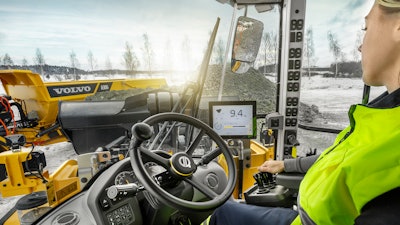 With Volvo Load Assist for L110H to L260H Volvo wheel loaders available through the optional Volvo Co-Pilot, operations can use telematics programs such as CareTrack or upload data to the cloud to monitor your total production and fuel consumption remotely,
With Volvo Load Assist for L110H to L260H Volvo wheel loaders available through the optional Volvo Co-Pilot, operations can use telematics programs such as CareTrack or upload data to the cloud to monitor your total production and fuel consumption remotely,
Payload management systems on loading tools allow loader operators to identify peak times, identify what material is being loaded out and avoid truck re-cycles for load adjustments, notes Schmidtgall. This frees up time to focus on the next customer.
To further aid productivity, Caterpillar has introduced a new feature to boost loading efficiency. “For wheel loaders, we have introduced to this industry the idea of low lift weigh,” says Schmidtgall. “Low lift weigh provides the ability for an operator to obtain an estimated weight of the current bucket load even before entering the traditional weigh range.
“This is beneficial in many ways,” he continues. “It results in faster cycle times since, on the last pass, the operator no longer needs to raise to the end of the weigh range only to realize he has too much material. The operator can simply engage a smooth, steady, slow lift out of the pile with the last bucket.”
The operator then gets an estimated weight, which can be as low as 40% lift height vs. traditionally 65% lift height. This results in up to 10% cycle time savings vs. traditional methods.
“He can then tip off material at the pile to the target he needs to complete the truck. Thus, a shorter cycle means he is saving labor time for him and the truck driver, and fuel as he is not carrying more material to the hauling unit than he needs. And he is not running the risk of dumping too much material into the truck,” says Schmidtgall.
Hauling unit scale systems not only allow operators to monitor how much payload they have on board. They also provide managers with an overall production picture such as average payload, cumulative production totals, fleet production totals and overall payload trends. This information gives managers the ability to optimize fleets and improve operational efficiencies for better profitability.
“With Volvo Load Assist for L110H to L260H wheel loaders available through the optional Volvo Co-Pilot, operations can use telematics programs such as CareTrack or upload data to the cloud to monitor total production and fuel consumption remotely,” says Yeomans. “An onboard weighing system is also standard for all Volvo articulated hauler models ranging from A35G through A60H in North American markets, so the cost to the end user is minimal when compared to the benefits of having the system.”


